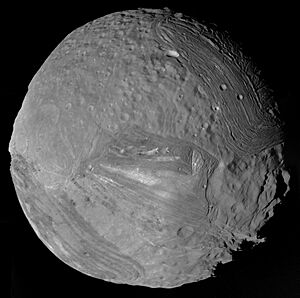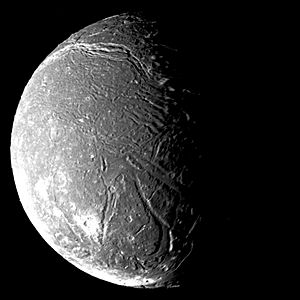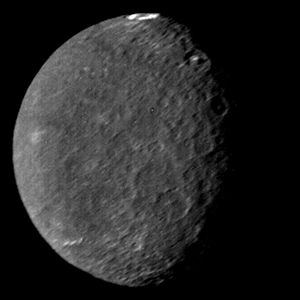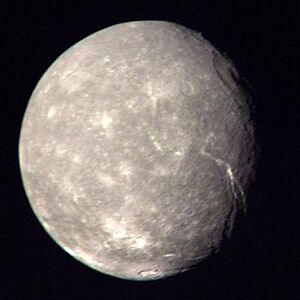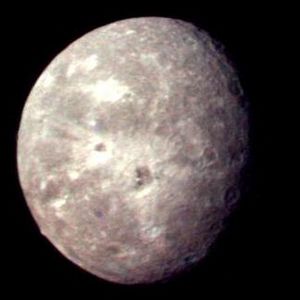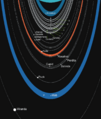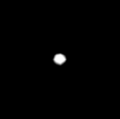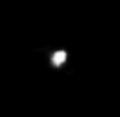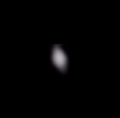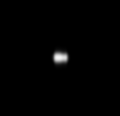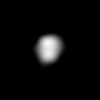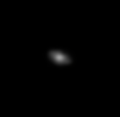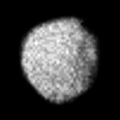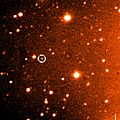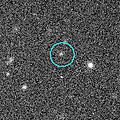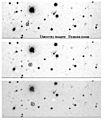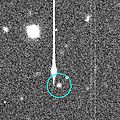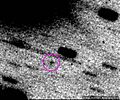List of Uranus' moons facts for kids
The moons orbiting Uranus are a fascinating group of celestial bodies! Scientists have discovered many moons around this icy giant planet. They are usually named after characters from the plays of William Shakespeare and Alexander Pope.
Uranus has two main types of moons:
- Inner moons: These are small and orbit very close to Uranus.
- Major moons: These are much larger and are shaped like spheres (like a perfect ball).
- Irregular moons: These moons are usually smaller and have orbits that are far from Uranus and often tilted or even backwards!
Scientists list these moons based on how long it takes them to orbit Uranus, from the fastest to the slowest.
Contents
The Inner Moons
Uranus has many small inner moons that orbit close to the planet and its rings. These moons are often named after characters from Shakespeare's plays. They are all quite small and have irregular shapes, meaning they are not perfectly round.
- Cordelia: This moon is about 40 kilometers (25 miles) wide. It was discovered in 1986 by the Voyager 2 spacecraft. Cordelia helps keep Uranus's outermost ring, called the Epsilon ring, in place.
- Ophelia: About 43 kilometers (27 miles) across, Ophelia was also found by Voyager 2 in 1986. Like Cordelia, it acts as a "shepherd moon" for the Epsilon ring.
- Bianca: Discovered in 1986, Bianca is about 51 kilometers (32 miles) wide. It's part of a group of inner moons called the Portia group.
- Cressida: This moon is about 80 kilometers (50 miles) across and was found in 1986.
- Desdemona: About 64 kilometers (40 miles) wide, Desdemona was discovered in 1986.
- Juliet: One of the larger inner moons, Juliet is about 94 kilometers (58 miles) wide. It was also found in 1986.
- Portia: The largest of the Portia group, this moon is about 135 kilometers (84 miles) across. It was discovered in 1986.
- Rosalind: About 72 kilometers (45 miles) wide, Rosalind was found in 1986.
- Cupid: This tiny moon is only about 18 kilometers (11 miles) wide. It was discovered much later, in 2003, using the Hubble Space Telescope.
- Belinda: About 90 kilometers (56 miles) wide, Belinda was discovered in 1986.
- Perdita: This moon is about 30 kilometers (19 miles) across. It was first seen in images from Voyager 2 in 1986 but wasn't officially discovered until 1999!
- Puck: One of the bigger inner moons, Puck is about 162 kilometers (101 miles) wide. It was discovered in 1985.
- Mab: Another small moon, Mab is about 18 kilometers (11 miles) wide. It was discovered in 2003 and is linked to Uranus's mu ring.
The Major Moons
Uranus has five major moons. These moons are large enough that their own gravity has pulled them into a round, spherical shape. They are also named after characters from Shakespeare and Pope.
Miranda
Miranda is the smallest of Uranus's five major moons, with a diameter of about 471 kilometers (293 miles). It was discovered in 1948 by Gerard Kuiper. Miranda has a very unique and jumbled surface, with huge cliffs, deep canyons, and different types of terrain all mixed together. Scientists think this might be because it was shattered by an impact and then reformed, or perhaps due to internal heating.
Ariel
Ariel is the fourth largest moon of Uranus, with a diameter of about 1,158 kilometers (719 miles). It was discovered in 1851 by William Lassell. Ariel is the brightest of Uranus's moons, meaning it reflects a lot of sunlight. Its surface shows many valleys and faults, suggesting that it has been geologically active in the past.
Umbriel
Umbriel is similar in size to Ariel, with a diameter of about 1,169 kilometers (726 miles). It was also discovered by William Lassell in 1851. Umbriel is the darkest of Uranus's major moons, reflecting very little sunlight. Its surface is heavily cratered, showing signs of ancient impacts, and it has fewer signs of past geological activity compared to Ariel.
Titania
Titania is the largest moon of Uranus, with a diameter of about 1,577 kilometers (980 miles). It was discovered in 1787 by William Herschel, who also discovered Uranus itself! Titania has a surface that shows both craters and large fault systems, which are like cracks in its crust. This suggests it has experienced some geological changes.
Oberon
Oberon is the second largest moon of Uranus, with a diameter of about 1,523 kilometers (946 miles). It was also discovered by William Herschel in 1787. Oberon's surface is heavily cratered, making it look very old. It also has a large dark spot on its surface, which might be a dark material that erupted from inside the moon.
The Irregular Moons
Uranus also has a number of irregular moons. These moons are much farther from Uranus than the major moons. They have orbits that are often tilted at a steep angle or even go backwards (this is called a retrograde orbit). Their paths around Uranus can change over time because of the pull from the Sun and Uranus itself.
- Francisco: Discovered in 2001, Francisco is a small moon, about 22 kilometers (14 miles) wide, with a retrograde orbit.
- Caliban: This moon is about 42 kilometers (26 miles) wide and was found in 1997. It has a retrograde orbit and is part of a group of moons named after it.
- S/2023 U 1: This is a newly discovered moon, found in 2023, and is very small, only about 8 kilometers (5 miles) wide. It's also part of the Caliban group.
- Stephano: About 32 kilometers (20 miles) wide, Stephano was discovered in 1999 and has a retrograde orbit.
- Trinculo: This small moon, about 18 kilometers (11 miles) wide, was found in 2001 and has a retrograde orbit.
- Sycorax: One of the larger irregular moons, Sycorax is about 157 kilometers (98 miles) wide. It was discovered in 1997 and has a retrograde orbit.
- Margaret: This moon is unique because it's the only known irregular moon of Uranus that has a prograde orbit, meaning it orbits in the same direction as Uranus spins. It's about 20 kilometers (12 miles) wide and was discovered in 2003.
- Prospero: About 50 kilometers (31 miles) wide, Prospero was found in 1999 and has a retrograde orbit.
- Setebos: This moon is about 48 kilometers (30 miles) wide and was discovered in 1999. It also has a retrograde orbit.
- Ferdinand: The farthest known moon from Uranus, Ferdinand is about 12 kilometers (7 miles) wide. It was discovered in 2001 and has a retrograde orbit.
Images for kids
Sources: NASA/NSSDC, Sheppard, et al. 2005. For the outer irregular moons, the most accurate orbital data can be generated with the Minor Planet Center's Natural Satellites Ephemeris Service. The irregulars are significantly perturbed by the Sun.


